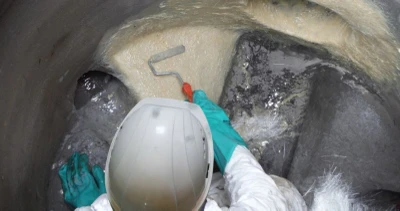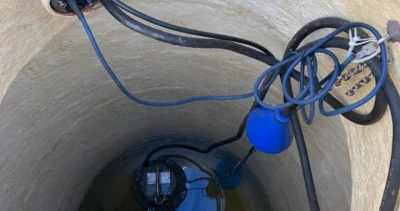With ombran SC, MC-Bauchemie has developed a styrene-free, odourless reaction resin for use as a hand laminate in sewer applications. It forms the core component of a complete system, which is complemented by the carrier material ombran L 450 and the catalyst ombran SC Cat L.
The complete system comprises of the two-component organo-mineral resin (also referred to as silicate resin) ombran SC, and the carrier material ombran L 450 — a tearable, powder-coated E-CR random-fibre glass mat with a standard basis weight of 450 g/m². As a fixed part of the system, the catalyst ombran SC Cat L enables flexible adjustment of the laminate’s curing time. It also allows the user to modify the viscosity of the resin. This simplifies the application of the final topcoat, made from thixotropically modified ombran SC, and facilitates overhead work in man-accessible structures. Pigmentation of the resin for visual impregnation control is unnecessary, as ombran SC naturally exhibits a light beige colour typical of organo-mineral resins, offering good contrast with the white glass fibres.
The low-viscosity, two-component organo-mineral resin can be easily applied to the substrate or worked into the glass mat using a standard short-pile paint roller. Each laminate layer can be quickly overcoated, allowing for continuous application. The resin cures quickly, even at low temperatures and without additional heating. At just 10 °C material and ambient temperature, a three-layer laminate is water-resistant within approx. 45 minutes thanks to the appropriate addition of the ombran SC Cat L catalyst. Unlike conventional laminating resins, ombran SC is completely odourless and free from styrene. This protects not only the applicator but also nearby residents from odours that could otherwise spread via the pipeline network into buildings.
The ombran SC laminate is fully bonded to the substrate. While this requires classical substrate preparation through sealing and usually blasting (as with coating systems), it eliminates the risk of groundwater-related buckling—a risk associated with prefabricated GRP panels that are only dowelled to the substrate.
The ombran SC system is usually applied as a three-layer laminate with an additional topcoat (also made from organo-mineral resin). In line with the requirements for short liner systems, a total layer thickness of at least 3 mm is targeted, resulting in a demonstrably watertight laminate. Additional dowelling is possible but carries the risk of leakage through the substrate.
ombran SC adheres to glass and synthetic fibre liners, short liners, mortar, concrete, brick, and ceramic. It can be used on dry and slightly damp mineral substrates and stands out for its high chemical and mechanical resistance. Thanks to its water vapour permeability, it does not form blisters due to osmotic processes or back-side moisture ingress.

Cured-in-place glass fibre liners impregnated with reaction resin have long been an established trenchless method for rehabilitating damaged sewer sections. In addition to structural reinforcement and sealing of the old pipe, a major objective is protecting the typically mineral-based structure from chemical attacks by wastewater components and biogenic sulphuric acid corrosion (BSC). The concept of using GRP laminates—glass fibre composites formed from resin-impregnated mats—has been adapted for use in manhole and structure rehabilitation.
Two types of laminates are distinguished:
On-site laminates can be applied in large or small formats, are suitable for complex geometries, and offer great flexibility. They also serve to create watertight connections to prefabricated systems, including large GRP pipes.
Until now, the wastewater market has been dominated by odorous, styrene-based resins made from unsaturated polyester or vinyl ester. As GRP laminates are also widely used in industries such as boat building and wind energy, resins not explicitly developed for sewer rehabilitation may find their way into use. These are often not part of a complete system, requiring users to manually mix various hardeners, pigments or additives for the topcoat. This increases the risk of both processing and fundamental application errors.
Random-fibre glass mats also vary in binding type, basis weight, and structure. Not all are corrosion resistant. In wastewater applications, only high-performance, so-called E-CR glass fibre mats (E-glass Corrosion Resistant) should be used to ensure the longevity of GRP laminates under aggressive, persistently damp sewer conditions.
Ombran SC enables a wide range of applications tailored to sewer conditions: from connecting liners in manholes or accessible sewers, coating channel inverts and benches, creating BSC-resistant full-surface linings, to supplementing GRP elements and panels. It can be used both for repairs and the complete rehabilitation of structures.

Although ombran SC is a newly formulated resin system based on the most advanced raw materials available, MC and the rehabilitation industry already have positive long-term experience with similar resin systems. Organomineral resins have been used in short liner rehabilitation for decades and usually hold general building authority approvals.
The organo-mineral resin cannot be classified into conventional laminate resin groups (e.g. DIN EN 13121) and exhibits significantly different properties compared to styrene-based resins. The fundamental suitability of the ombran SC on-site laminate system is proven by numerous serviceability tests.
ombran SC, like all commercial organo-mineral resins, is subject to EU Commission Regulation 2020/1149, which mandates that industrial and professional users be trained in the safe handling of diisocyanate-containing products (“isocyanate licence”). As a result, these systems are under close scrutiny, and users are comprehensively trained in a ~90-minute session, improving both safety and application quality.
Furthermore, workplace measurements at real rehabilitation sites and under worst-case conditions show that permissible limits under "TRGS 900 – Occupational Exposure Limits (01/2006)" for diisocyanates (MDI) are significantly undercut—even without ventilation—meaning that, when safety regulations (e.g. external ventilation) are followed, there is no health risk from on-site laminate application.
Due to ombran SC being solvent-free, its handling differs slightly from styrene-based resin systems. Particular attention must be paid to venting each laminate layer and properly applying the topcoat. Since its market introduction, MC’s sales and application engineering teams have provided extensive user support.
To ensure long-term application quality, Professor Dr.-Ing. Karsten Körkemeyer from the Chair of Construction Management and Construction Economics at the Rhineland-Palatinate Technical University of Kaiserslautern-Landau (RPTU) developed a new certified training course within the long-established CROM training series for manhole rehabilitation. The course is called “Certified Laminator for Sewer Structures (CROM–GLA)” and has been offered across Germany since 2021. Supplementary refresher courses, required every two years, help reinforce knowledge.
The two-day training covers materials science, substrate preparation, laminate work preparation and application, environmental protection and occupational safety, both theoretically and practically. Upon successful completion of both theory and practical exams, participants receive a certificate and competency ID.
We are continuously improving our website and we use cookies for this purpose. For an optimal user experience, we recommend that you accept them. Otherwise, parts of the page will be deactivated in the display in accordance with data protection regulations.